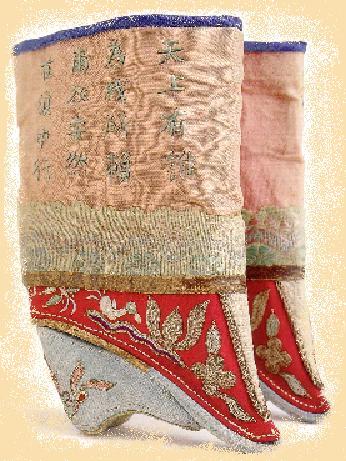Popularity

Footbinding was so popular during the 18th and 19th centuries that different regions began to develop their own styles of lotus shoes. The above map highlights the main regions that have very distinct characteristics.
There were some superstitious beliefs associated with footbinding. One example was that on Chinese New Year or other traditional festivals; women would wear their lotus shoes and go to the temple in groups to pray for good luck. Footbinding was also the preparation of a good marriage. No matter how charming and talented the girl was, if she did not have a pair of properly bound feet, she would not be considered a good wife. Many wedding customs involved footbinding as well, varies between Northern and Southern China. There were beauty pageants at the temples for men to praise and to decide who would be the Queen of Lotus.
The controversial novel of the Ming Dynasty-- Jin Ping Mei--ª÷ ²~ ±ö has promoted the beauty of footbinding quite extensively. The protagonist of the book bears the name "Golden Lotus" for her beautiful three inch long feet. The title of Golden Lotus has since become a household name.
Besides all the different celebrations and practices, footbinding was also involved in many fetishes. People were so obsessed with women's feet, they began to eat and drink off the odoriferous lotus shoes. Some prostitutes used their lotus shoes to serve drinks to their clients, sometimes even used them as ashtrays. All of these fetishes were simply the tool to increase erotic pleasures and sexual amusements.

This pair of embroided shoes with a prayer sewed on it is a typical gift from a girl to her love in the late 19th century.
The translation would be:
Who on heaven,
Can I lean on?
May you go in peace,
Across the waves!
May God bless you,
'Til we meet again!
Meet again, meet again!


